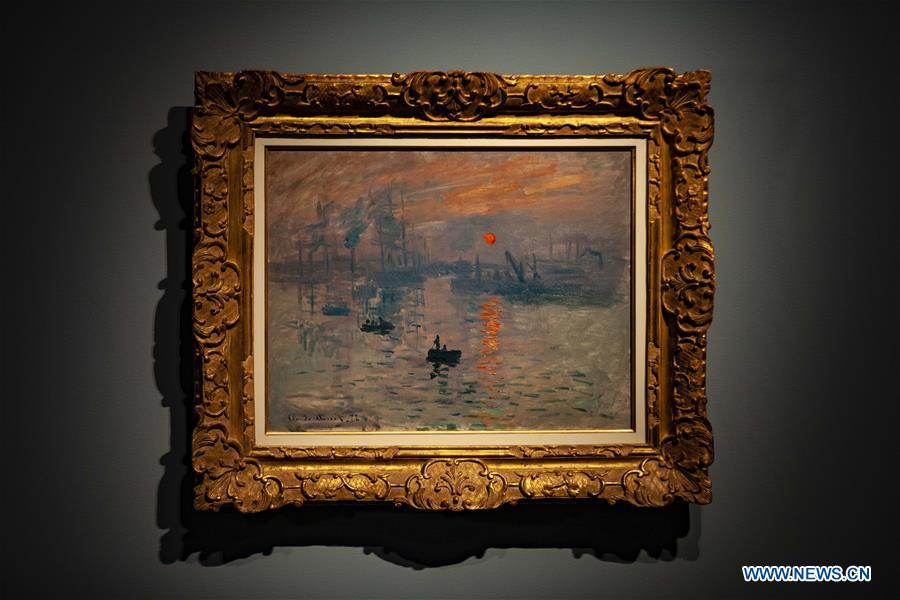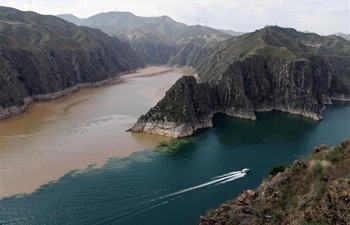
Claude Monet's "Impression, sunrise" is seen at the National Gallery of Australia (NGA) in Canberra, Australia, June 6, 2019. An exhibition titled "Monet: Impression Sunrise" will run in Canberra from June 7 to Sept. 1. Sixty works from the Musee Marmottan Monet, the Tate in London, as well as other institutions and private collections in the U.S., Britain, Australia and New Zealand, will be displayed at the exhibition. (Xinhua/Pan Xiangyue)
CANBERRA, June 6 (Xinhua) -- In Australia where the sun always shines brightly on the clear blue sky, audiences now have a chance to see the rising sun over a French foggy harbor in Claude Monet's eyes.
"Impression, sunrise," Monet's iconic masterpiece which gave Impressionism its name, has come to the National Gallery of Australia (NGA) for the first time in an exhibition of 60 works from the Musee Marmottan Monet, the Tate in London, as well as other institutions and private collections in the U.S., Britain, Australia and New Zealand.
The exhibition, titled "Monet: Impression Sunrise," will run from Friday (June 7) to Sept. 1.
"Discover the story behind Monet's ground-breaking masterpiece - the artists that influenced him and learn how 'Impression, sunrise' inspired a movement," said Nick Mitzevich, Director of NGA. "Monet was a radical. We see him at a pivotal moment in his career, a period which redefined art."
According to Marianne Mathieu, Scientific Director of the Musee Marmottan Monet, the work "Impression, sunrise" seldom left the museum. "Having it here in Canberra for three months is exceptional," she said.
She said that the exhibition will take visitors on a journey through Monet's exploration of light, his influential masterpiece that marked the dawn of Impressionism, to his study of nature, culminating with his most loved waterlily series.
The Musee Marmottan Monet is home to the largest collection of Monet in the world, including more than 100 paintings donated by the artist's son.
Mathieu especially talked about "Impression, sunrise," which are hanging along with paintings of sunrise and sunset from other artists. As a young artist, Monet painted it in 1872, capturing a passing moment at the harbour in Le Havre from his hotel window.
"It changed the history of art," she said. "It is a symbol of Impressionism. Before this painters used to work in their studios, with candlelight. With impressionism, the artists decided to go outdoors. It has two consequences: the first is that they had clear colors, and the second one is that they had to paint very quickly."
Pointing at the painting, she said "we can see clearly here it is almost an abstract painting, non-figurative."
Simeran Maxwell, curator with the NGA, said that 'Impression, sunrise' is so important today that it still inspires artists.
"Putting this work in the context of art that inspired him, and then what he went on to achieve afterwards, including our own works including haystacks midday and waterlilies at the end of his career. So we have the start and the end of his career, all in one exhibition," she said.
She told Xinhua that there were over 20 Monet works in the exhibition, among which two were from the NGA collection.
From 1888 to 1891, Monet, in his 40s, focused on painting stacks of grain to show how light affected their appearance at different times of the day, different seasons and weather conditions.
Waterlilies is another important series of his. He created more than 250 paintings for his garden at the late period of his career, many of which were painted when his vision declined.
Apart from Claude Monet, the exhibition also featured Turner, Delacroix, Courbet, Whister, Sisley and Morisot.











